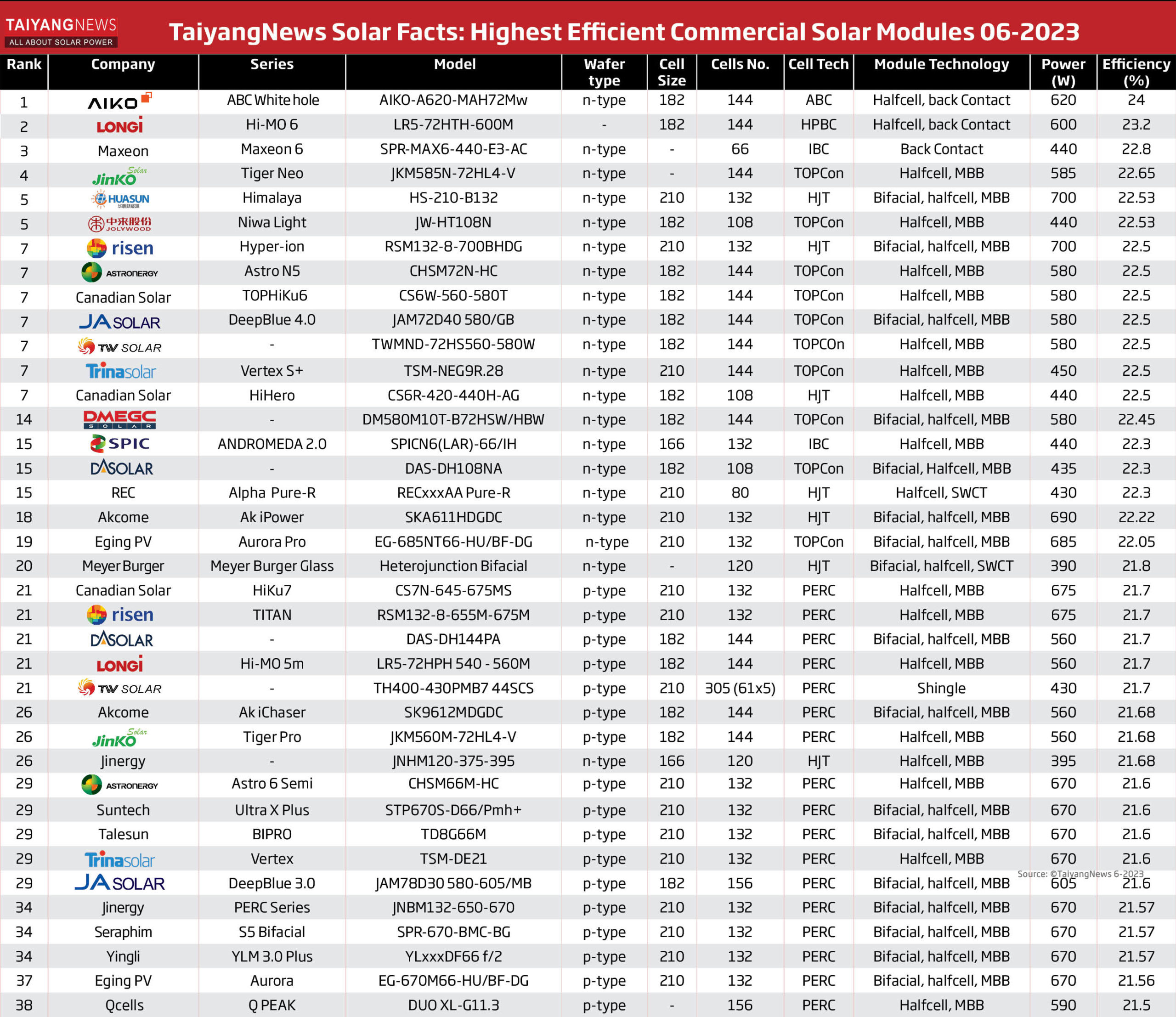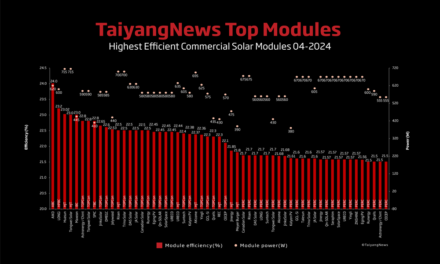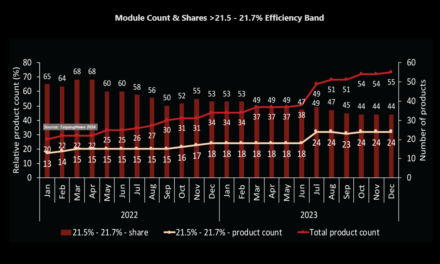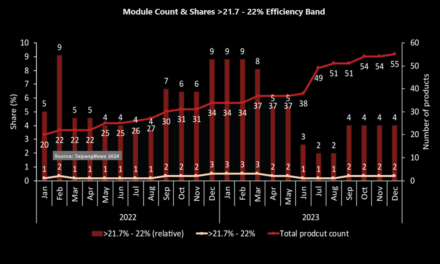- AikoSolar Solar breaks its own record by offering a solar module with 24% efficiency
- Three new PV modules are listed – from Risen Energy, Canadian Solar and DMEGC, the latter is a new entrant
- Risen introduces 700 W panel based on HJT solar cells
- A total of 38 products from 25 cell/module manufacturers are listed in this June TOP SOLAR MODULES edition
The race for the highest solar module efficiency has gained momentum of recent month. Only 2 months after creating commotion in the solar sector by commercializing a module with an efficiency surpassing the 23% benchmark, one of the leading Chinese cell manufacturers Aiko Solar, that recently expanded into modules as well, has come out with yet another breakthrough of commercializing a 24% efficient solar panel. With this product, which it displayed first during the SNEC trade fair in China and soon also at Intersolar Europe, Aiko breaks its own previous record of 23.6% that featured in our TOP SOLAR MODULE feature since March. The latest product of Aiko has a 10 W higher power rating of 620 W. Like its predecessor, this module product is also from its ABC module series that relies on back contact cell architecture. In our previous edition, we included LONGi Solar’s Hi-MO6 module with an updated efficiency of 23.2%. As a result LONGi’s earned the unshared No. 2 position, which it was sharing with Maxeon before May 2023.
During the world’s largest solar show, SNEC 2023 in Shanghai, which concluded at the end of last month, several companies have commercialized advanced versions of its product range that is also reflected in the current TOP SOLAR MODULES list. In addition to Aiko, products from 4 companies are new to our ranking. Interestingly, 3 out of 4 of these new products have the same efficiency of 22.5%, the fourth is very close. Risen Energy’s Hyper-ion module is as high-power 700 W 22.5% efficient module that is listed for the first time. Canadians Solar’s latest monofacial module has a 0.2% points higher efficiency of 22.5% than its latest best product. A new Vertex S+ module from Trina Solar comes with a 0.2% point improvement over the previously listed product as well. And DMEGC, an altogether a new entrant to our listing, is promoting a TOPCon module with an efficiency of 22.45%..
As a result in these new developments, the number of companies are now 25, one more than last month with total 38 products listed. Please note that the data for top modules was collected in the last week of May 2023, soon after SNEC.
For background
Efficiency and output power are the 2 key characteristics of a solar module. While there are several means to improve module power such as employing larger cell sizes or integrating more cells into a module, it’s the efficiency that truly speaks about the ability of the solar device to convert sunlight per area into power. That’s why this list includes only the highest efficient solar modules.
TaiyangNews has been covering the efficiency progress of solar modules through its annual reports on Advanced Module Technologies starting from 2017 and its annual conference as of 2020. Our latest Solar Module Innovations Report was published in Aug. 2022 (download report here) and our most recent annual conference on Solar Module Innovations took place on Jan. 31, 2023 (access the presentations here). However, in the quickly changing solar sector a lot is happening over the course of a year – and to keep our readers updated about the efficiency progress more frequently, TaiyangNews has started this monthly column on commercial TOP SOLAR MODULES at the beginning of 2022.
Methodology
Before going into details, here is some background on the methodology and selection criteria: Since module efficiencies have been improving considerably in recent years, more than 0.5% average per year, to make the list rewarding for technically advanced products, we put the minimum efficiency to be included at 21.5%. We have listed only commercially available top modules from each cell technology stream of one module maker. For example, if a company is offering 2 different product streams based on PERC technology that have more than 21.5% efficiency, then only the product with the higher efficiency is considered for this list. But if a module maker is offering, for example, products based on PERC and TOPCon that have efficiencies of 21.5% or above, then both the products are listed here. Efficiency is the only criteria for ranking in the list (whenever available in the specs, we have used two digits after the comma for efficiencies, otherwise one). However, as we see more often products with the same efficiency, in this case power determines the order. And when efficiency and even power are the same, we have listed the manufacturers in alphabetical order.
A commercially available module is considered a product for which the complete data sheet is listed on the module producer’s website. The efficiency and power data listed here is taken from the data sheet available on the respective company’s website. This also means, we have not included any new product announcements without final technical data published as their modules specs often differ considerably from the products that are finally available for purchase, and some products presented at trade fairs are not even seeing the commercial light at all. Finally, we are only listing modules based on in-house produced cells of a respective module manufacturer, which means modules using externally sourced cells are not featured in this TOP MODULES list. If module specs listed on websites seem to have ‘conspicuously’ high efficiencies, we ask for certificates from third-party test institutes among other information before we include a product in the list.
Results & Changes
Meeting these criteria, according to our research (status last week of May 2023), a total of 38 products from 25 companies have made it to the current list – one more product and one new company than previous month. In principle it should be 2, however, the other change with respect to the previous listing is a de-listing of Qcells’ TOPCon module as the data sheet was no longer accessible on the website during our research at end of May 2023.
Aiko’s ABC module series remains at the top, but with higher efficiency of 24% surpassing its own previous high of 23.6%. The latest module product is rated with up to 620 W power coming from 144 of M10 half cells. It has exactly the same specs as the earlier version, only that it has 10 W higher power, which is indicated in the model name – AIKO-A620-MAH72Mw. Aiko has not specified the exact cell architecture, but it’s based on n-type wafers and characterized as ABC that is also the designation of the module series and stands for All Back Contact. The module efficiency was certified by TÜV SÜD and the product is also commercially available. As a proof Aiko has also provided a list of projects, in which the module series has been used in commercial scale installations.
The Hi-MO6 module from LONGi was updated last month – at 23.2% it has remained unchanged in the No. 2 position. LONGi’s product is based on its proprietary HPBC cell technology, which is essentially a back contact cell architecture. Apart from being top class in efficiency, the new Hi-MO6 module series is powerful too. It reaches up to 600 W in the highest power class. The 144 (6×24) half-cell panel is a single glass (3.2 mm) product with an anodized aluminum alloy frame, measuring 2,278 x 1,134 x 35 mm and a weight of 27.5 kg. The up to 23.2% efficient module comes with a 25-year power warranty with <1.5% power degradation in the first year and an average of 0.40% from years 2 to 25.
In consequence, Maxeon’s 440 W and 22.8% efficient IBC cell based panel moved down to 3rd position. Until April, Maxeon and LONGi were sharing the same rank, and before LONGi introduced its HiMO 6 end of 2022, the IBC modules from SunPower spin-off Maxeon have been the most efficient products in the market for many years.
Jinko Solar holds the 4th position with its Tiger Neo TOPCon module JKMN-72HL4-V that is offered with a power rating of 585 W and an efficiency of 22.65%. Huasun and Jolywood share the 5th rank. Both products have the same efficiency of 22.53% but for different rated module power. Huasun’s HJT module with 700 W, until recently the solely most powerful on the list, is based on G12 wafer size in a 132 half-cell configuration; Jolywood’s product is based on TOPCon technology and uses M10 wafer format in 108 cell configuration. Its Niwa Light product has a rated power of 440 W.
Risen Energy’s Hyper-ion module is new module included in our ranking. In fact, the module specs were tagged as “draft” on the company’s website in the past, thus the product was included in our list only now. This HJT module from Risen has an efficiency of 22.5%, corresponding to high rated power of 700W. The product is built with 132 half cells, cut from 210 mm original format, and it is bifacial. It shares the 7th rank with 6 other products in the list.
Astronergy’s Astro N5 series, which increased efficiency of 0.1% last month remains unchanged in 7th place.
Canadian Solar’s TopHiKu6 TOPCon model comes with 22.5% efficiency, which is 0.2% higher than its previously listed bifacial module. As a result the ranking of this module has moved up from 11th to 7th position. CS6W-560-580T has 144 half cells with 182 mm wafer format – and reaches 580 W compared to the earlier product with 575 W. Interestingly, one more product from Canadian Solar also shares the 7th rank. However, this HiHero series is based on HJT. To reach an efficiency of 22.5%, it employs 108 G12 wafers in half-cell configuration. Named HiHero, the module though is rated at a lower power rating of 440 W.
The top products from JA Solar and TW Solar which joined the list in April 2023 have remained unchanged. The JAM72D40 580/GB, a TOPCon product from JA Solar has 22.5% efficiency for a power output of 580 W. TW Solar’s TOPCon product has exactly the same efficiency and power ratings of 22.5% and 580 W, respectively, thus both are sharing the rank. Both the products are built with 144 half cells using G12 wafer format.
The latest Trina Solar’s Vertex S+ module is yet another new member of the group sharing the 7th rank. It is based on TOPCon technology and the latest products features a high efficiency of 22.5% compared to 22.35% previously, as a result its ranking moved to 7th from 11th place. This module uses 210 mm wafer format and is built with 144 half cells leading to an output power of 450 W.
Thus the companies sharing 7th rank now increased from 4 to 7.
DMEGC, the 1st time entering our TOP SOLAR MODULES is promoting a TOPCon module that qualifies our criteria. This bifacial module is designed with 144 halfcells of 182 mm wafer format that ultimately reaches an efficiency of 22.45% and a corresponding rated power output of 580 W.
SPIC’s IBC module, based on German solar research institute ISC Konstanz’s Zebra technology, stands on 15th place as well with the same 22.3% efficiency but a lower power rating of 440 W.
Again, it shares that rank with DAS Solar. DAS Solar is a Chinese cell and module manufacturer from which we have listed 2 modules – one comes with TOPCon, a technology it commercialized very early on, and another is based on PERC cell technology. The TOPCon module of the company is rated with 22.3% efficiency; this 435 W module is made up of 108 cells. Another module comes from PERC technology product; its DAS-DH144PA has 21.7% with a rated power of 560 W. Both module from DAS solar are based on 182 mm wafer format built with multi busbar design and have bifacial technology.
REC shares its rank with the above 2 companies. The Singapore based manufacturer’s Alpha Pure-R series HJT product has 22.3% efficiency and 430 W module power.
With the above changes Akcome now stands at 18th position. The company’s Ak ipower HJT module has an efficiency of 22.22%. This HJT module is built with 132 half cells based on 210 mm wafer size and reaches a rated power of 690 W. Akcome also provides a 560 W bifacial PERC module, built with 144 half cells sliced from M10 cells, and having an efficiency of 21.68%. There, it shares the rank with JinkoSolar’s Tiger Pro PERC module which has the same efficiency.
Eging PV’s AuroraPro series module is a TOPCon based bifacial module with an efficiency of 22.05%, which means the 19th place in this ranking. The module has a rated power of 685 W.
Qcells, TOPCon product was unavailable on its website during our research period for this edition, so we have delisted it. However, its PERC module is included. The PERC product line, called Q PEAK series remains unchanged since our March 2022 edition with a rated efficiency of 21.5%.
The remaining 19 products listed are below 22%, of which 2 are based on HJT, and the bulk of 17 are PERC modules.
As previously, Meyer Burger is offering its HJT product with the same efficiency of 21.8% and power rating of 390 W. Jinergy is another HJT technology company, whose product is based on M6 cell format and reaches 21.68% module efficiency.
There are several module series with efficiencies slightly exceeding 21.5% available today as high efficiency cell architectures are not a must to reach that level, but in order to design products today beyond 21.6% the cell technology is key. As shown in the graphs, PERC in general was not been able to support efficiencies above 21.6% until end of last year. At the time, modules with efficiencies above 21.6% were generally employing cells based on high-efficiency cell architectures such as IBC, TOPCon or HJT.
But as of recently, we have observed an increase in the number of companies reaching PERC module efficiency to 21.7%. Until November LONGi and Risen were in this group; then, in January, Canadian Solar joined; TW Solar joined in February; and in April DAS Solar entered the list of 21.7 efficient PERC modules – and all of them are ranked #21. Following the order of rated power, the third module of Canadian Solar in this list, its HiKu7 is based on 132 half-cell configuration with 210 mm wafer size and a rated power of 675 W. Risen Energy has moved up in order of listing with increase in power from 450 W to 675 W. Risen’s TITAN module is built with 132 half cells using 210 mm wafer format, compared to the earlier model that was based on 130 of 1/3rd cell strips. That’s why though the difference in cell number is just 2, the power rating has increased by 225 W with the currently listed product. LONGi’s HiMO5m module is built with 144 cells of 182 mm cell size and 560 W power. TW Solar, which was listing a 21.5% efficiency products until February, has come up with a 21.7% product that reaches a power output of 430 W. Like its predecessor, this product is also based on shingled interconnection technology, striping cells into 5 and a total of 61 cells are used to build this shingled module.
If rounded, the next 3 sharing rank 26 would also reach 21.7%, but the companies – Akcome, Jinko and Jinergy – have given 2 digits in their spec sheets. JinkoSolar’s Tiger Pro is a module with 21.68% efficiency based on 144 cell configuration resulting in a rated output of 560 W. Akcome has a bifacial product with the same number of cells, cell format and output of Jinko. Jinergy’s HJT module, however is built with 120 half cells of M6 format that reaches a power of 395 W.
The remaining 10 products are all based on PERC, of which 5 reach 21.6% efficiency. Interestingly, 4 products of this group – Astronergy, Suntech, Talesun and Trina Solar have the same power rating of 670 W owing to the same cell count of 132 cells of G12 size. JA Solar’s DeepBlue 3.0 built with M10 sized 156 half cells has a different power rating of 605 W. The other 5 PERC modules ranging from 21.57% down to 21.5% all still meet our criteria of at least 21.5% efficiency and include products from Jinergy, Seraphim, Yingli, Eging PVand Qcells of which 2 but Qcells, Seraphim and Yingli have another high-efficiency product listed as well.
Summary
In this version of June top solar modules listing, Aiko once again surprised the industry; it not only broke its own record, it is now the only module in the commercial space that can reach a benchmark solar module efficiency of 24%. For now 22.5% seems to be a new magic number; as many as 7 companies are sharing the 7th rank in the current listing. Three new products – from Canadian Solar, Risen and Trina Solar – have been added to the previously listed products from Astronergy, TW Solar, JA Solar and again Canadian Solar. The catch here is Canadian Solar is offering two different products streams – TOPCon and HJT modules – with the same efficiency of 22.5% though different power ratings.
Then we have a new company that has entered in to our module efficiency ranking – DEMGC from China – with a TOPCon module rated with 22.45% efficiency.
LONGi Solar’s Hi-MO6 module is still ranked 2nd with an efficiency of 23.2%. Maxeon’s IBC module, previously tied with LONGi, moved to third place with an efficiency of 22.8%.
Other notable modules in the list include JinkoSolar’s Tiger Neo TOPCon module, holding the 4th position with an efficiency of 22.65%, and Huasun and Jolywood’s module with the same efficiency of 22.53% securing and sharing the 5th rank. We also now have 2 modules with 700 W efficiency, one from Huasun, and a new one from Risen Energy, both relying on HJT technology.
The list consists of modules with efficiencies above 21.5% and various cell technologies such as PERC, TOPCOn, HJT and IBC are represented. The power output and efficiency are the main criteria for ranking the modules. The rankings are based on commercially available modules from module makers with their own cell production – and the complete datasheets need to be on the respective manufacturer’s website.
Please check our TOP SOLAR MODULES H1/2023 report for which we have looked at the monthly columns for the last 18 year of this ranking- with a focus on H1/2023, and analyzed the trends and developments for the different cell technologies (PERC; TOPCon, HJT, Back Contact) and listed companies (see TOP SOLAR MODULES H1/2023)
PS: If you have spotted somewhere a solar module that meets our criteria and might be missing in this list, please send us the link of the website with the product specs to [email protected].
Disclaimer: TaiyangNews does not guarantee reliability, accuracy or completeness of this TOP SOLAR MODULE Listing’s content. TaiyangNews does not accept responsibility or liability for any errors in this work.















